Naples. Birthplace of pizza and neighbor to a couple of the most famous cities lost to a volcano, Pompeii and Herculaneum. Though I’d visited Pompeii and Herculaneum a few years ago with a class from seminary, Kirk had never been, so we stopped in this well known city for some fantastic food and history.
Arriving in Naples we hopped in a taxi and directed the driver to the address of our Airbnb. He weaved through the streets of this large city full of cobblestones and eventually we came to a stop. Pointing up at a alleyway full of large stairs our driver said, “There. You must walk.” We stared up this weaving staircase unable to see the end in loo of all the turns, loaded ourselves with all our bags, and up we went. To our misfortune, our Airbnb was at the very top of the street at what turned out to be right around 100 stairs up (yes, I counted out of curiosity one day 😂 – and my count didn’t include the additional two floors we climbed in the building upon arrival).
Though trudging up the stairs wasn’t our idea of fun with all our bags in tow, it was definitely a dive head first into everyday life in a city like Naples. This was one of the many stair alleys that are the only way to reach a lot of the housing in this hilly city. As I slowly made my way up the alley carrying both a backpack on the front and on the back, I imagined what it would be like to move into this alley – carrying each box up this same path before heading back down for another. I also imagined what it must be like for anyone living at the top of the alley who buys groceries in bulk 😬. Surely no one does that 😂. Different ways of life are so fascinating. It seemed like hard work to daily climb the road to me, but it probably keeps the parts of the population living there in good health for longer periods of time. We watched older individuals with canes climbing up and down the streets confidently. I’m sure that at some point it does become a problem, but I am also certain we were in better shape but the time we left too 😂.
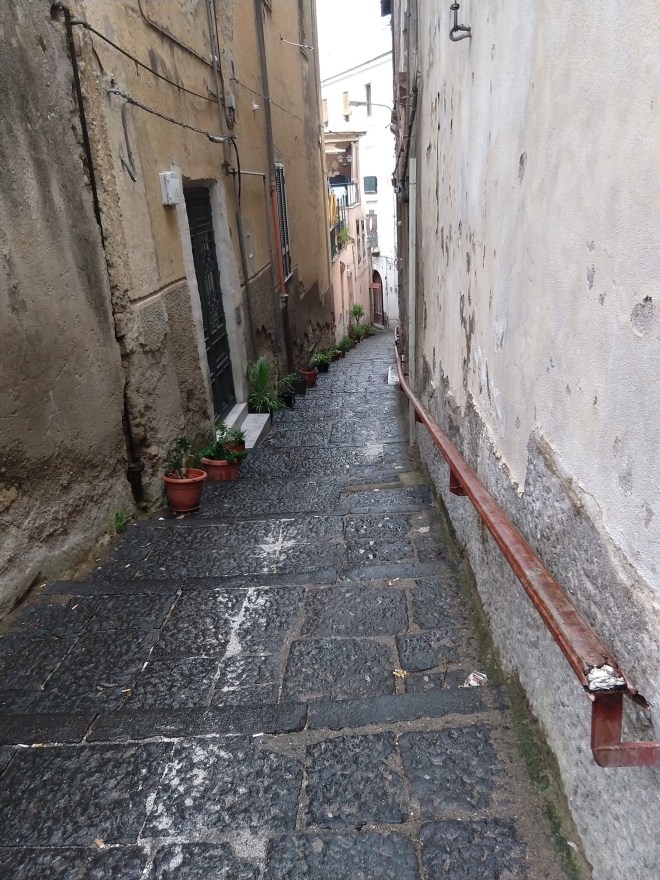
A section of the alley leading down from our Airbnb.
Our first night in the city we decided to try a dish the city is famous for outside of pizza – Ragu. We found a well reviewed restaurant and wandered over and it turned out to be quite tasty. Kirk’s ragu had roast and ricotta, mine had smoked provolone that was to die for. Oh man, next time you make tomato sauce, add smoked cheese – big chunks of it 🙂

My dinner and ragu dinner date.
Of course there were plenty of other things we tried during our time there too. Naples is also well known for several different types of pastries and below are a few of those.

Sfogliatella – shaped like a clam, and filled with sweetened ricotta and candied citrus peel. There are a few different versions of this, but this is the only one we tried. Quite tasty.
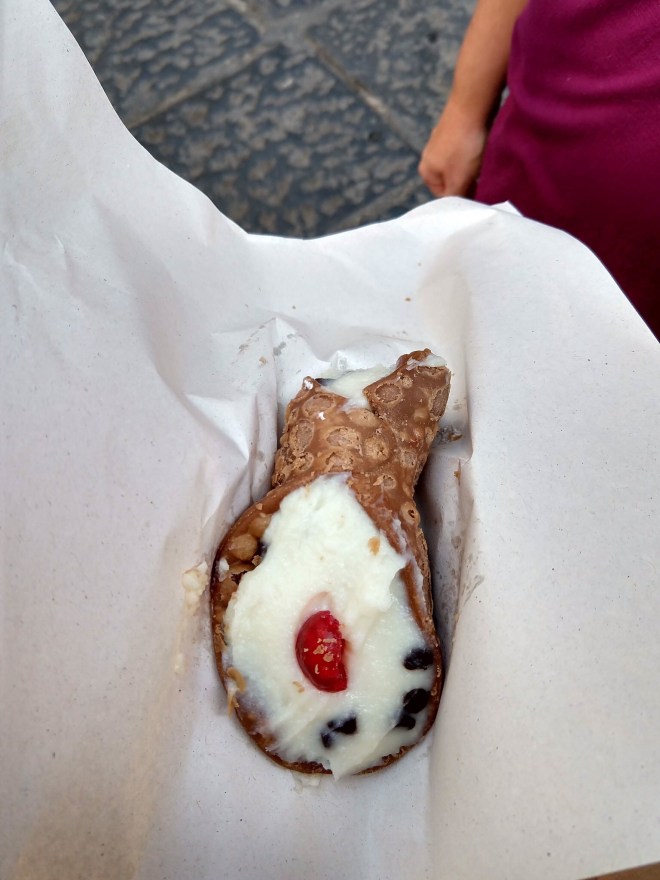
The well known cannoli, filled with a cream with chocolate chips in it.
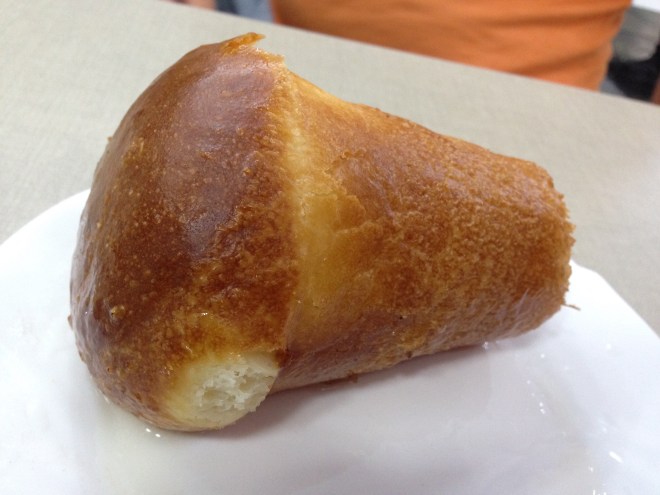
Baba – an especially famous dessert from Naples. This is a sweet bread soaked in rum. People here apparently love it, it but I thought it tasted like a dinner roll dipped in rum 🤷♀️. Not my favorite, but maybe we just got it at the wrong place?
One thing we tried that was certainly not disappointing was the pizza. Our favorite pizza was one we ate right outside Pompeii that had fresh olive oil, Parma ham, arugula, cherry tomatoes, garlic, and some kind of cheese. Something about the quality of those ingredients made it stand out among the rest even though we had others like it later. It was yummy!
Our most common experience in Naples around pizzas were with street pizzas. There are small stands set up right outside many pizzerias that serve personal sized, wood fire stone oven cooked margarita pizzas for 1-2 euros. The first place we tried one was a small joint called Di Matteo that had a picture of Bill Clinton eating there hanging out front alongside a ridiculously long line every time we walked by. Their pizza sold for $1.5 and though at first taste I found myself impressed with the fresh flavor of the tomato sauce, at the same time I didn’t think it wasn’t anything special (simply tomato sauce, with a little mozzarella and a single basil leaf). However, after trying other small pizzas on the street I came to learn why this place was so popular. The secret really is in the sauce. As long as you are expecting what you are getting (a mostly tomato sauce pizza) you too will recognize the delicious that Di Matteo is if you ever visit.
Below is a picture of a small pizza that was mediocre, but it serves as a good example of how they serve these street pizzas – folded in four.
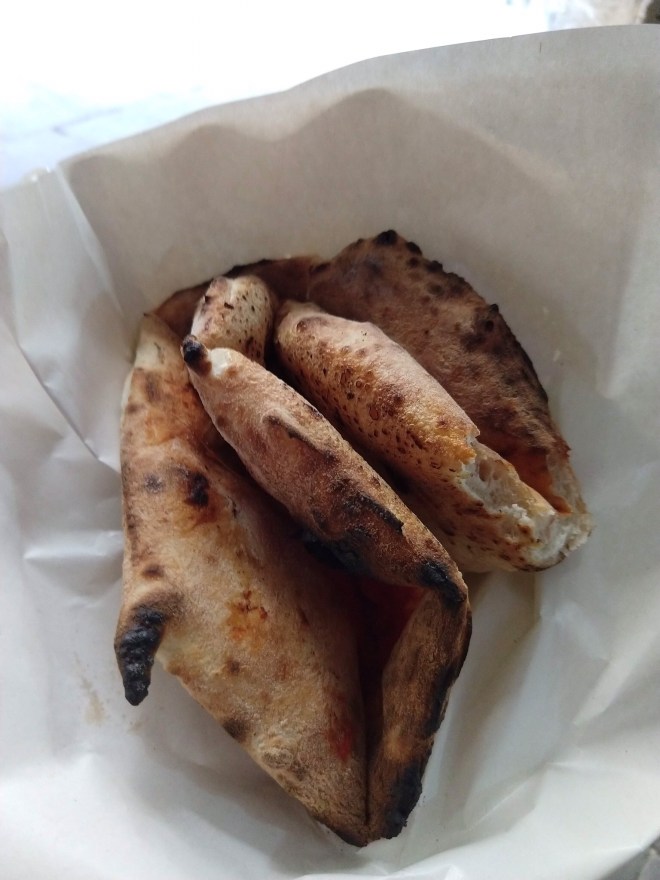
Street pizza, essentially eaten like a sandwich.
Most of our days in Naples were spent wandering the city. As I mentioned before, it’s a pretty charming place with it’s old buildings and many cobblestone streets.

A food stand selling pasta and treats.
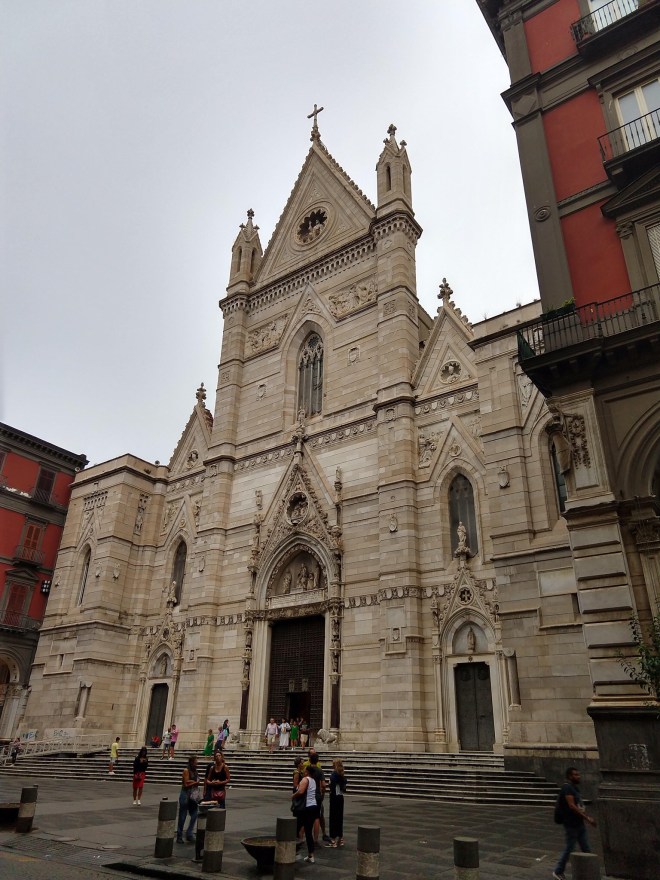
An old church in the tourist district.

A large column with a statue of one of the former popes on top surrounded by common charming buildings in the area.

A statue of Dante (as in Dante’s inferno) in one of the city squares.
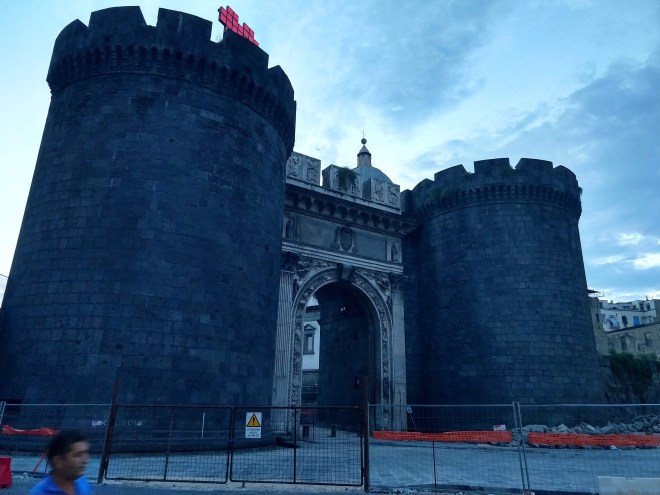
Part of a castle still standing.
One of the fun places we visited in Naples were the underground cisterns. Though Naples has excavated sections of an ancient city that you can visit underground, we found ourselves more interested in the old Greek cisterns since this underground area was used as a bomb shelter by the citizens of Naples in WWII. Most of these underground cisterns are simply large rooms that used to hold water, but imagining the time it took ancient Greeks to make these rooms alongside the experience of seeing artifacts left behind from the war make this a pretty interesting place to visit.

Our tour group in one of the large dark cisterns.

A collection of toys and household items left behind from when this underground area was used as a bomb shelter during WWII.
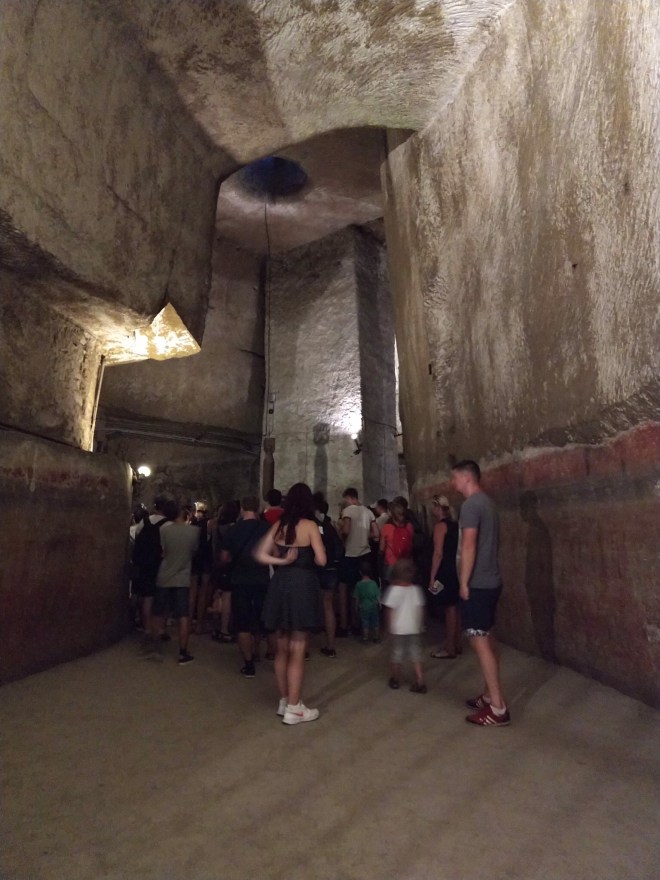
Look how big these rooms are! They were carved out by hand! The red on the wall shows where the water level once was when this was still used as a cistern system, although, the current floor was a later addition – the original floor was much lower.
At one point in the tour we went through a long unlit area that was so small we had to turn sideways to fit through it. They gave us led candles to guide our way through. Below is a photo of me with the candle. My back is on the back wall and the candle is on the front one.
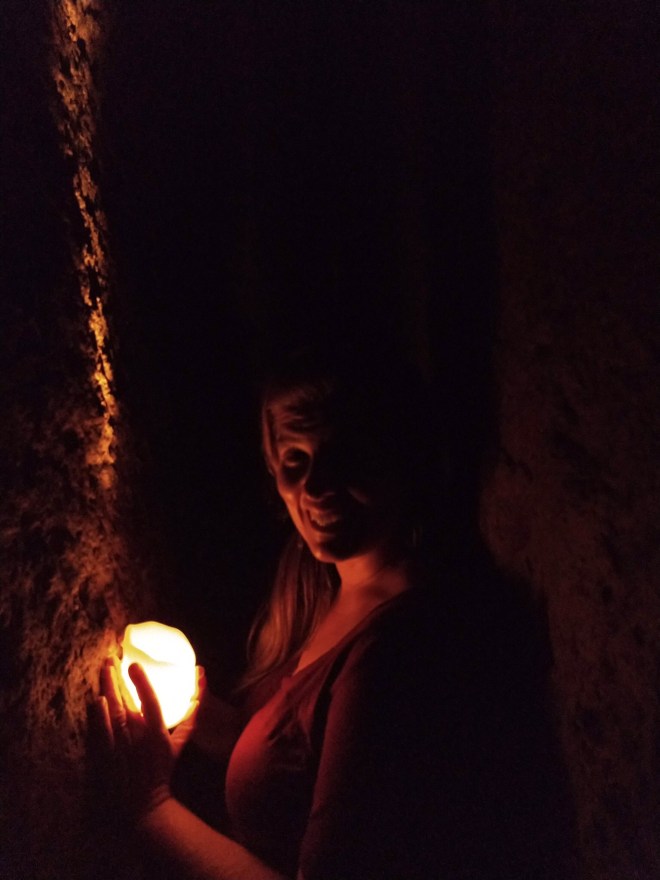
Walking through the long thin hall
At the end of the hall we came to a very large room still filled with water as a better example of what this area still looked like as a cistern.
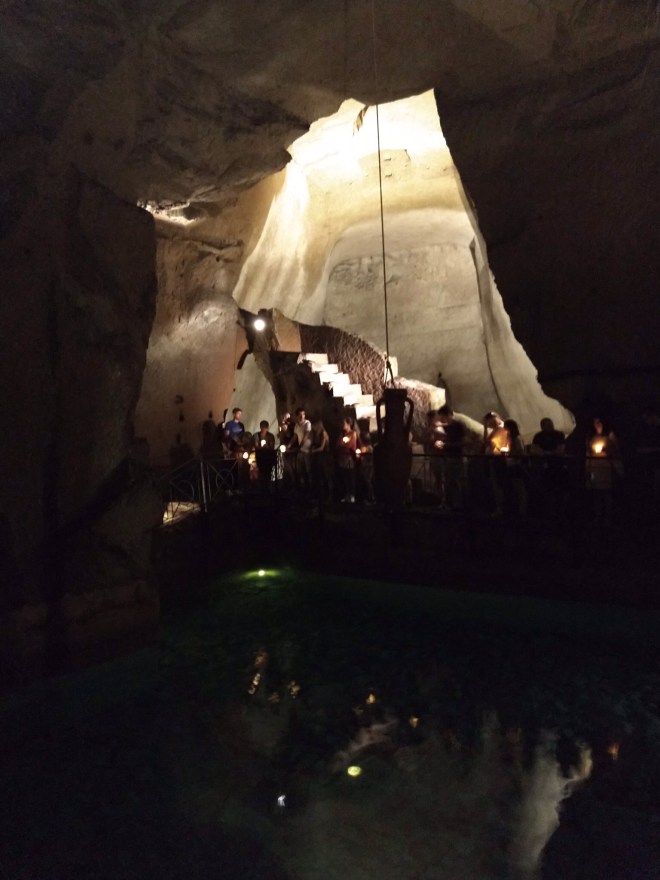
The jar is coming down from the well opening above
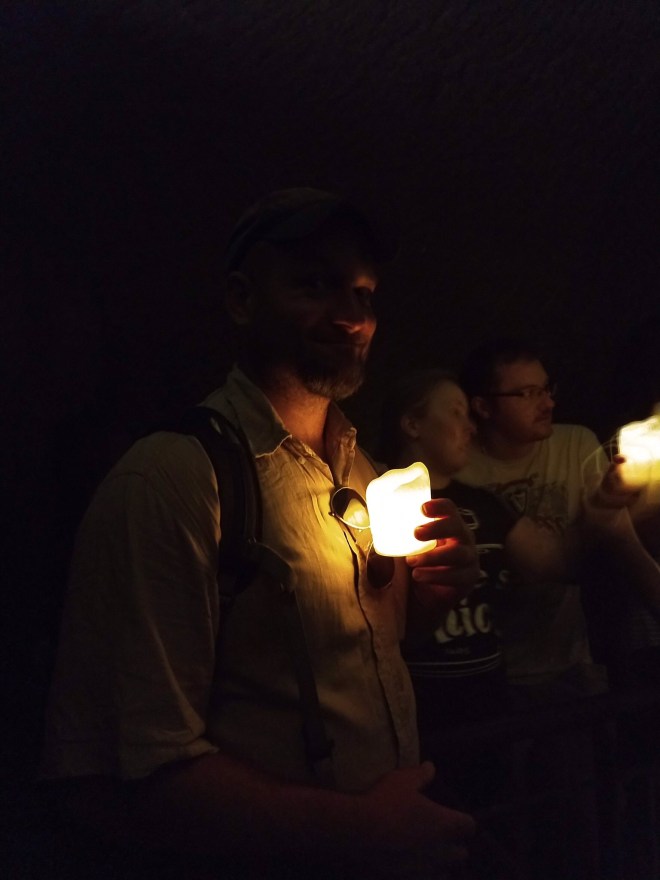
Kirk and his candle 🙂
The last place we visited in the cisterns was an area that was below a church. In the past, the nuns from the church turned this cistern into a cellar, where they fermented the wine for communion. All that’s now left are some barrels and bottles, but it’s certainly a fun additional for the history of this place! 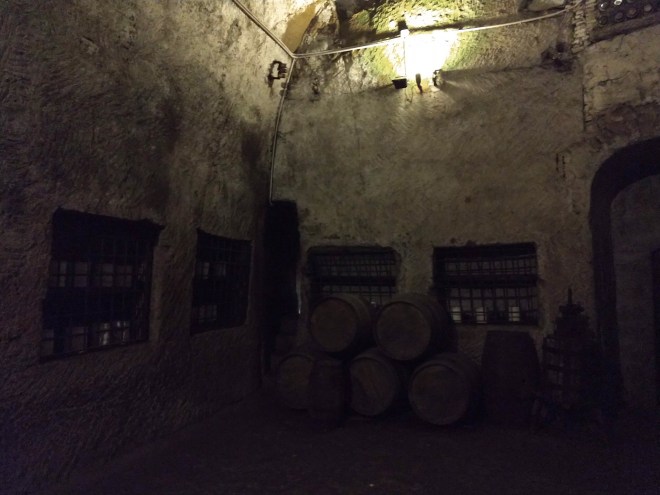
Cistern turned cellar.
Though the cisterns were interesting, our favorite part of the tour ended up being the very end when they took us to see an old Roman theater that had been lost for years. I don’t remember the exact date, but in very recent history (I want to say 1970’s or 80’s) someone put together the pieces and realized that this missing theater was right in the middle of town, now functioning as housing units. At some point in history, the walls of the theater were plastered over and incorporated into the design of modern day apartments. One woman’s apartment in particular is the star of the show, and when it was realized what her apartment was, she was well compensated to find a new home. It now functions as an attraction for tourists. Those photos are below.
The story goes that when the men searching for the old theater first arrived in this woman’s apartment, they were struck by the arches. No other apartment in this area has space or arches quite like the apartment in which this woman was living. Upon examining the walls, they found that underneath the plaster were old Roman bricks, and when they pointed them out, the woman said, “Oh, there are many more of those in my basement!” She them took them to a secret door that was hidden under a rolling bed in her apartment, and when they went down, they were certain of what they had found.
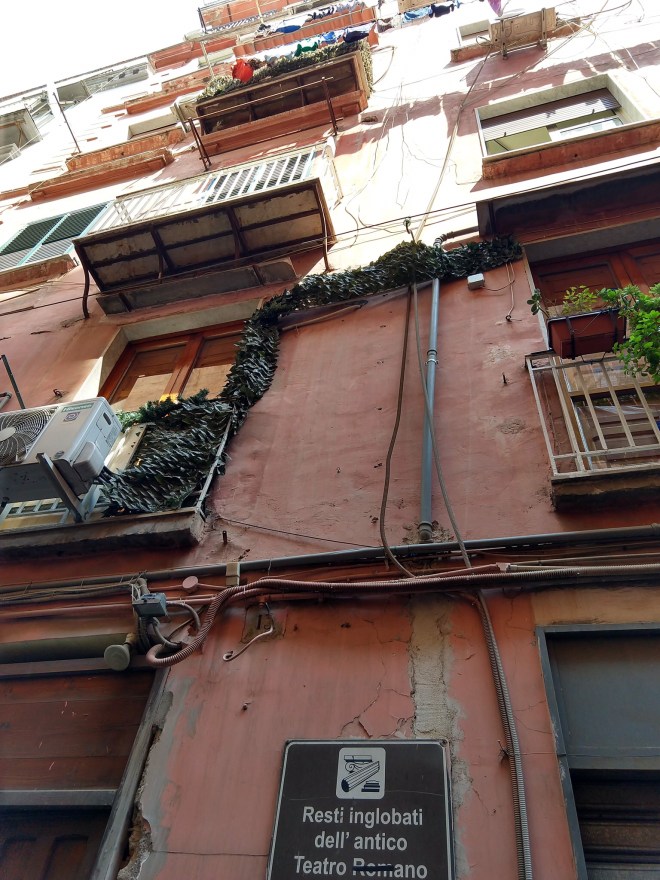
Looking up at the apartment building on top of the theater

Inside the woman’s apartment – the many arches of the apartment that gave clue to the original history are here in view and the old brick now revealed is on the right. This woman was living in an ancient theater!

Walking down into the basement via the once hidden door.
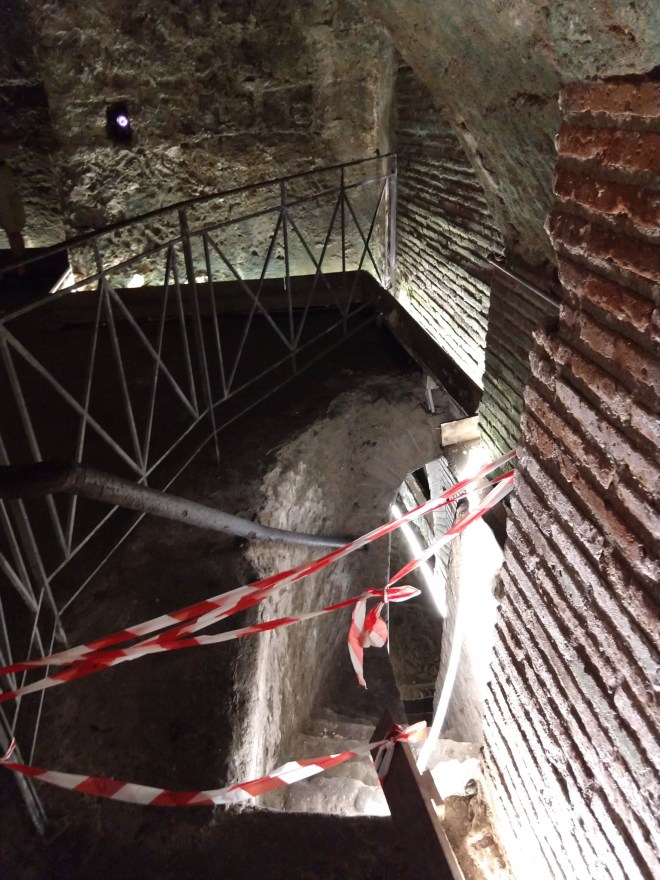
In the basement where the stairs (that we weren’t allowed on) continued down even farther into the rest of the theater.

The other side of the basement. How crazy right?!
If this were my basement, and I was still unaware that it was once a Roman Theater, I’m fairly sure I would have swung between the thoughts of- “Wow, what a beautiful basement I have!” and “What in the world were they thinking when they built this basement of halls?” 😂
The city and tourism has now also commandeered other areas of the apartment complex that help make for a more interesting visit. Below is a space where you can peek out of the ruins into a common area of the apartment complex. The area where we are standing was once the scooter parking lot for the building.

Peeking into the modern complex from the ancient ruins below
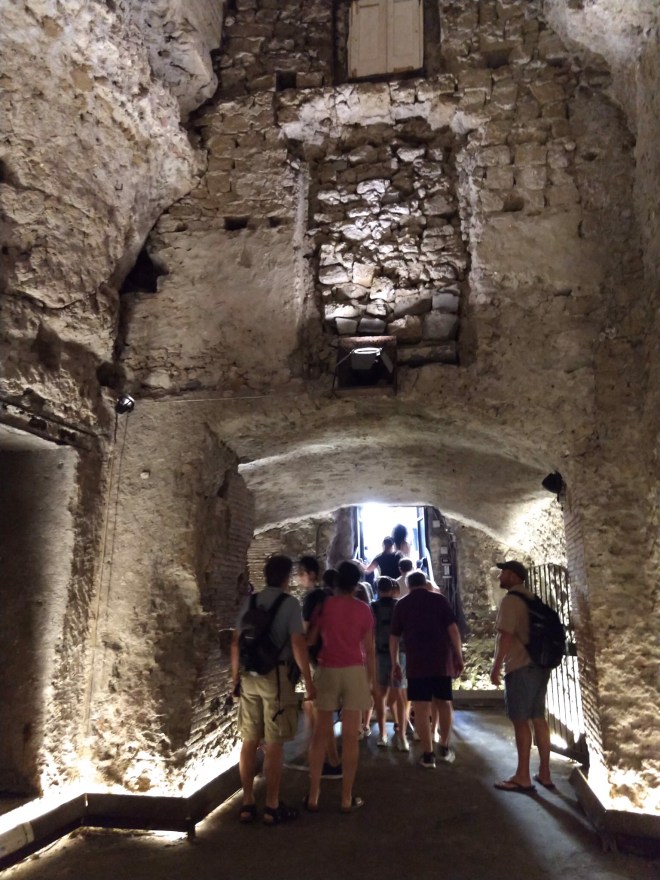
A better look at what was once the scooter parking area for the building.
Before the end of the tour we went to a final area of the building that they’ve gained access to – the area from where Nero would have watched shows.
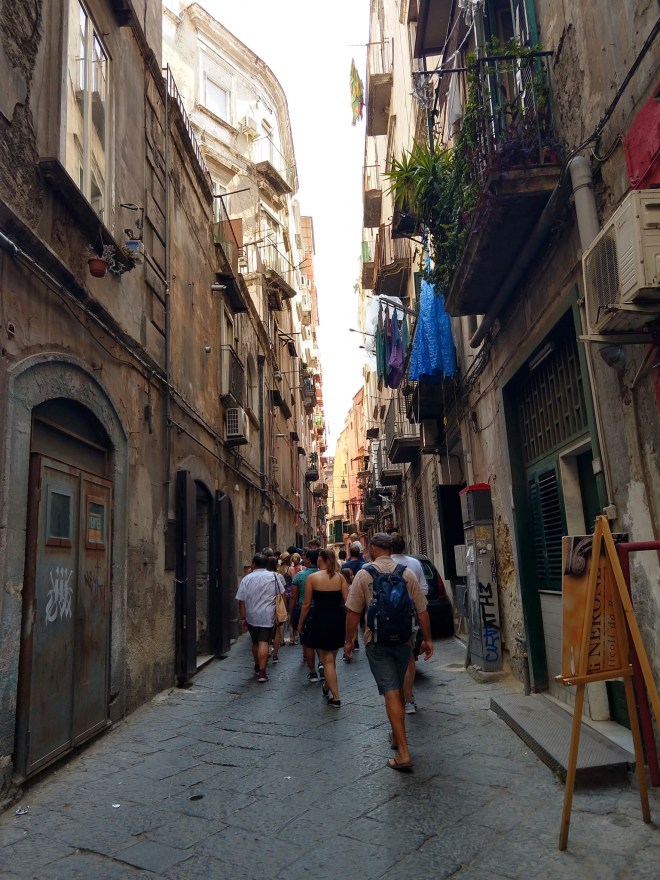
Our group walking into the apartment building that houses this section of the ancient theater. How crazy is it that this very old theater is supporting all these new structures?

Inside the area where Nero’s seat at the theater would have been. Those modern windows in the wall connect to hotel that advertises that your window will look into the old Roman theater – true advertising!
After visiting the underground, we decided to spend the next day doing the opposite – going up – climbing Mount Vesuvius (and visiting Pompeii 😊). After spending so much of our trip climbing and hiking we were delighted to learn that you can climb this volcano that made history. If you don’t know anything about Mount Vesuvius/Pompeii, below is a little history.
Mount Vesuvius is an active volcano that has erupted many times throughout history, but the most famous of these eruptions was in 79 AD when the volcano exploded and rained down ash that covered the cities of Pompeii and Herculaneum. In a way, this hot ash froze the cities in time, and shockingly, when the city was discovered and excavated nearly 1800 years later, under the ash, elements that normally would have rotted over time were found fully preserved – wood, paint, petrified poop, and even a loaf of bread. Items like these told us details about diet and ways of life from that time that couldn’t have been known otherwise. The cities of Pompeii and Herculaneum have taught modern civilization more about ancient Roman civilizations than any other site that’s been discovered, and it’s all because of Mount Vesuvius. What closed the door on their society has opened the door into the Roman world for us. It’s tragic and fascinating.

On top of Mount Vesuvius, looking out at the cities and sea below. Pompeii is visible from the other side of the volcano, to the left.
We joined with a free tour group to learn a little more about the history of the volcano. Based on the four shirtless people in view below, clearly it was a warm day 😂.

Tour group on the volcano top talking with the volcanologist – Kirk with the backpack in blue.
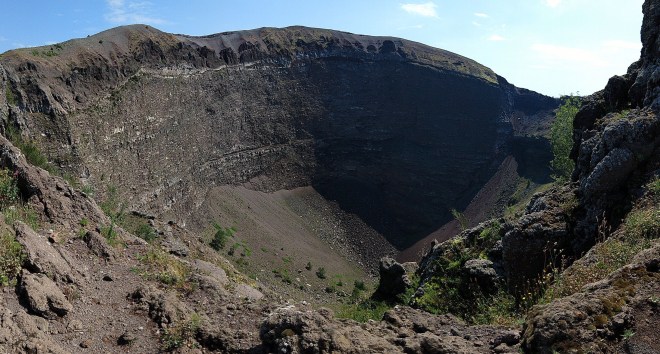
A small panoramic looking down into the crater. The photo makes it look small, but this guy was huge!

On the other side of the volcano, Kirk’s hand pointing at Pompeii.
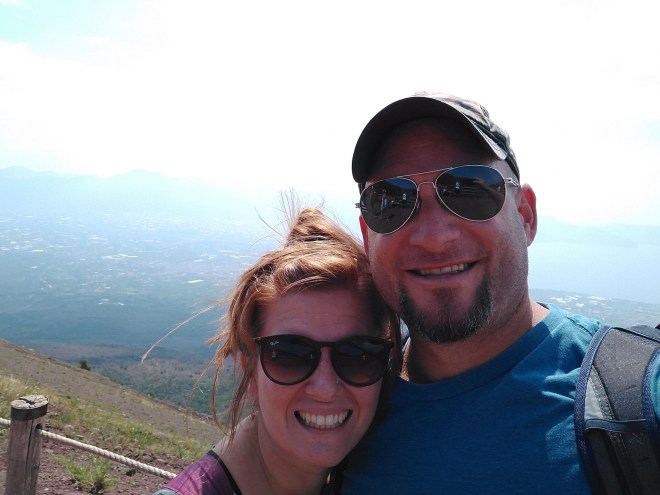
Selfie in front of the Pompeii view

Selfie in front of the crater

Heading back down the volcano on the trail. It was quite sandy!
After climbing Vesuvius, we ate lunch (where we had that delicious arugula pizza I mentioned earlier), and then Kirk headed into Pompeii on his own. Being on a tight budget, I didn’t mind sitting out since I’d visited there only two years prior. Below are some photos from Kirk’s time in Pompeii. As I mentioned before, the entire city was covered in ash and preserved, so now, there is nearly an entire ancient city uncovered to explore (they are still excavating parts of it).
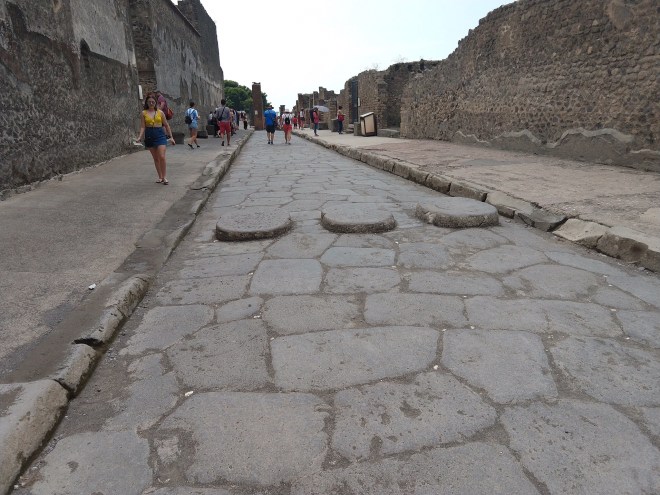
The streets on Pompeii. Those stones in the middle are walking stones for pedestrians when it’s raining. They are spaced perfectly for chariot wheels to go in between them. It was pouring the day I visited the city two years ago, and those stones came quite in handy!
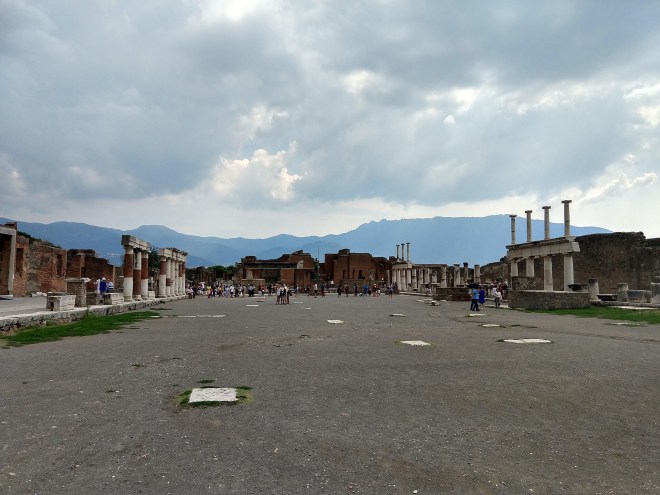
The city square, where many temples were built.
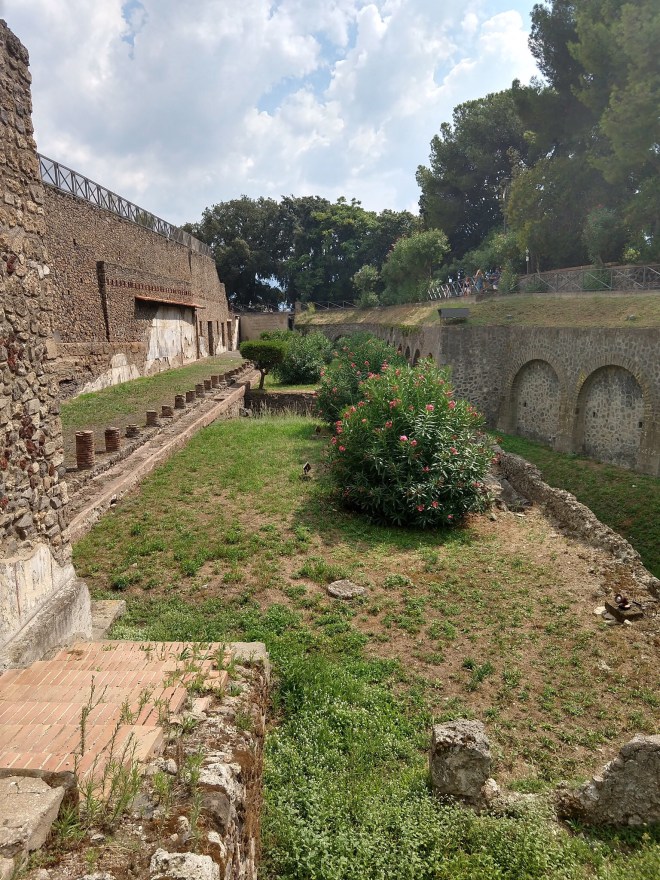
The edge of the city – those bricks pegs to the left are where boats would have once been tied. Pompeii was a port city located on the ocean full of merchants and tradesmen, making this a society full of majority middle class individuals.

A replica of some old art found in the city
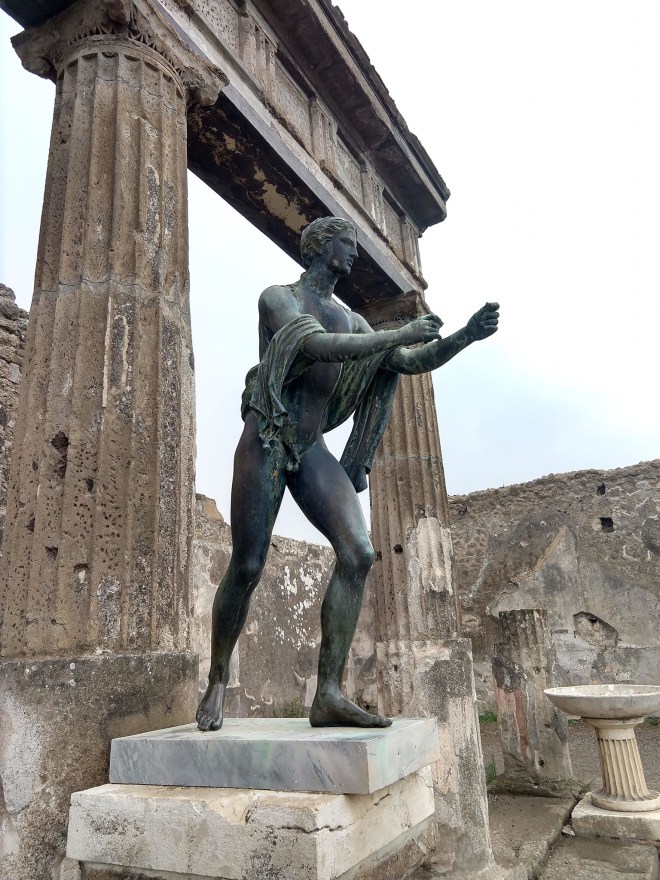
More art from the city
I mentioned before that when the ash fell on the city, many things were preserved – though it certainly wasn’t everything. When the excavators came across cavities in the ash that existed because what once filled the cavities had decayed, they would fill the cavity with a mold that they would then cast into a statue to see exactly what once filled the holes. Heartbreakingly, many of these cavities had human bones in the bottom of them and the casts revealed the exact positions these individuals were in when they died. Some of the casts are now on display, and you can even vaguely make out facial expressions on a few of them. It’s unbelievable that such a thing exists. Nearly 2000 years ago these people died in these positions, and we still have pictures into that time today.
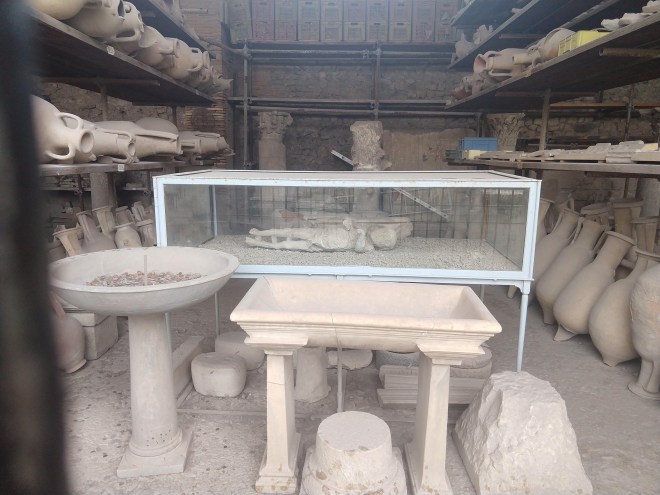
The cast of an infant that was found
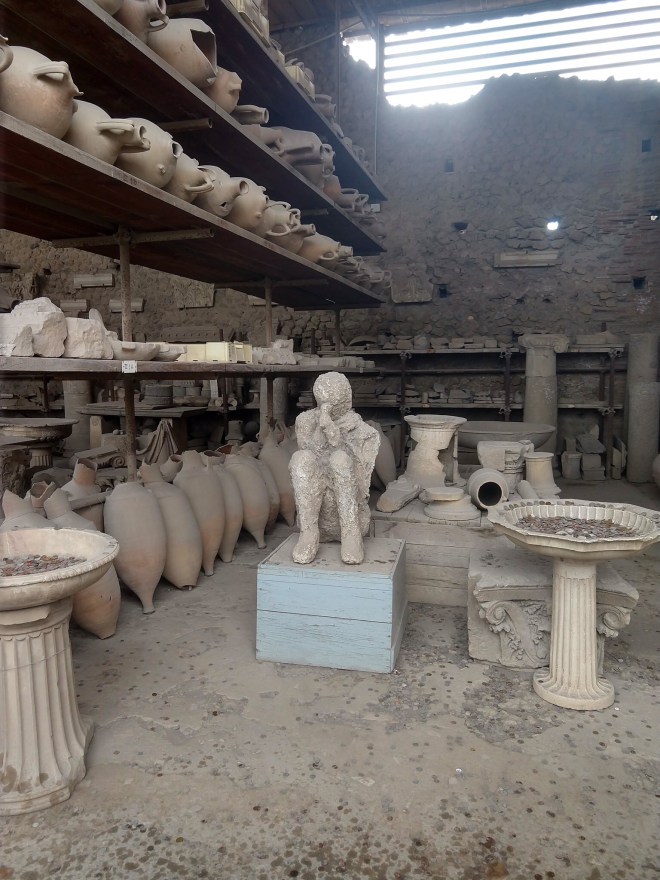
The cast of an adult crouching with their fists to their face. Imagine sitting like this as ash falls from above, covering everything around you.

The cast of an adult, turning his back towards the falling ash. This is one where the facial features are clear.
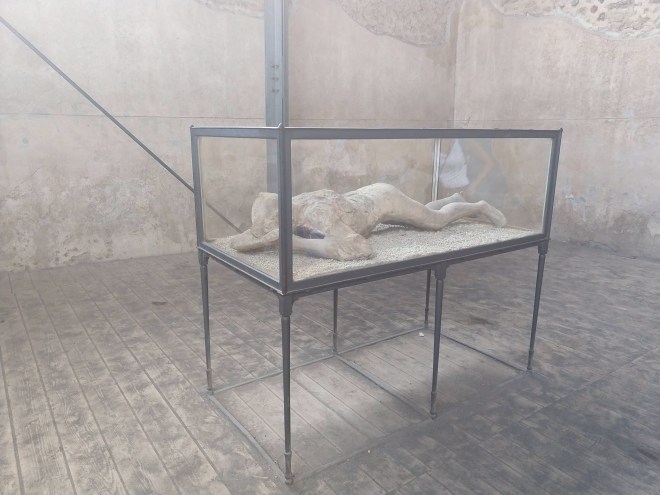
Another adult, hiding her face, back to the ash.
The city has plenty of other sites as well.

A “fast food” restaurant. These are all over the city, some with built in pots on the counters in which to keep the food.
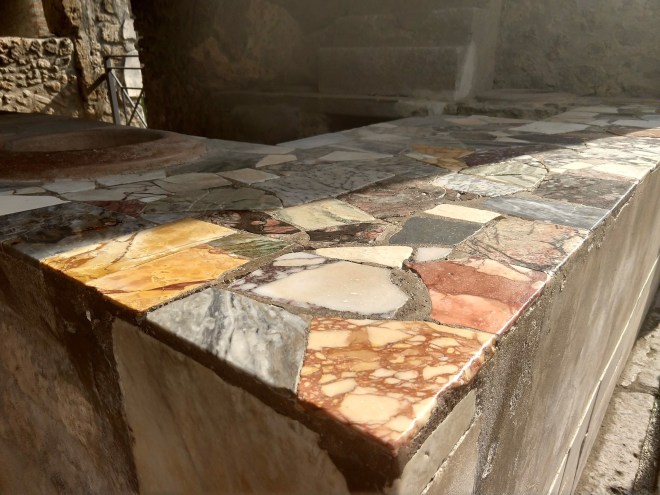
Another buffet – the colors in this one are so beautiful!

Inside one of the bath complexes.
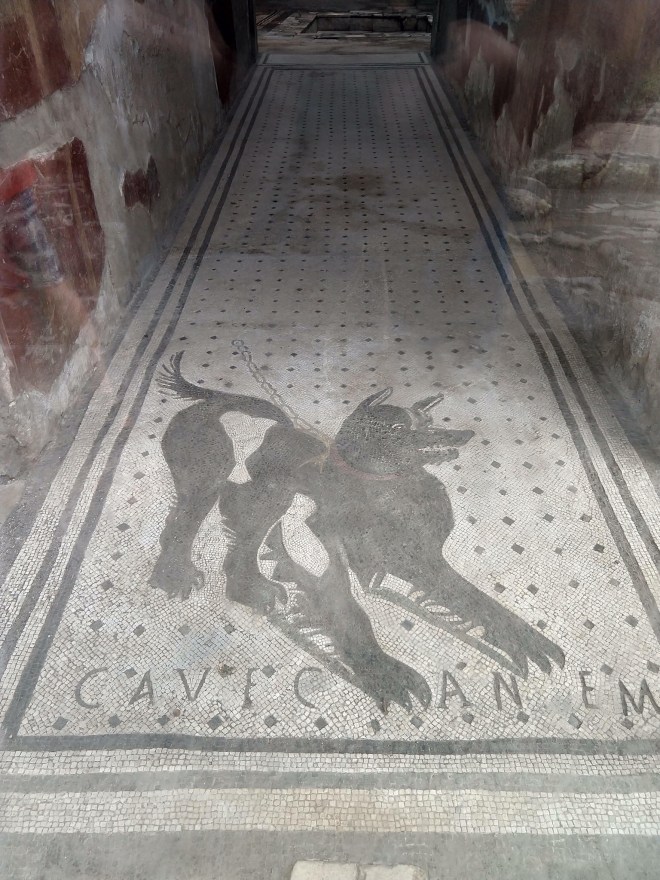
The entrance to a house with a mosaics that says “Beware of dog” 😂
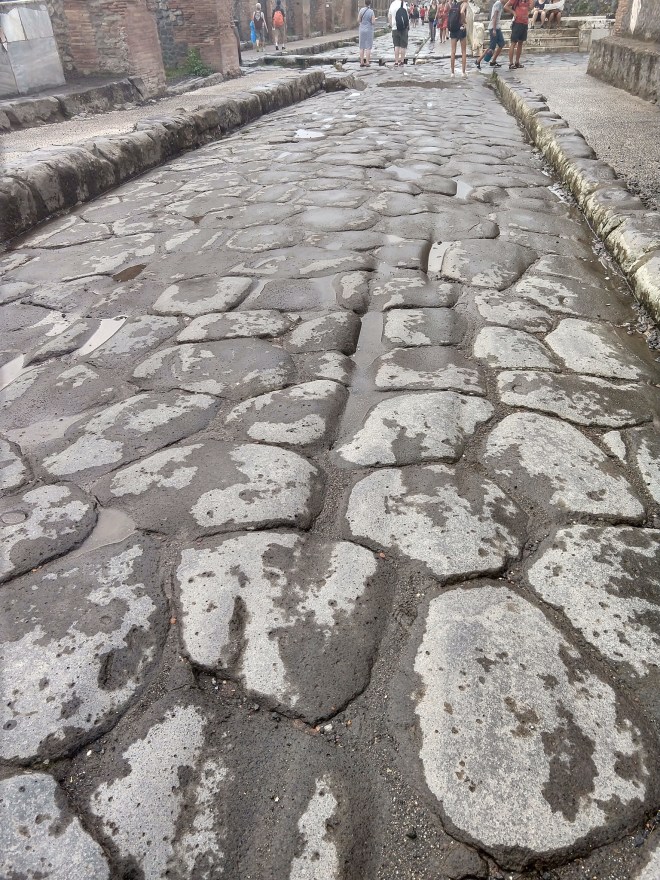
Chariot grooves in the road

A famous statue from this time that was on display in the courtyard of one of the houses in Pompeii. The photo above shows a replica now on display where the statue was found, the original is in the Pompeii museum, which we visited later. It’s small, but impressive! It catches movement perfectly and nearly looks like it’s skipping towards you in person.
In addition to some impressive art and structures, Pompeii had an impressive extensive three tier system for their pipes. In the event of a water shortage, the water to the wealthy was cut first, the water to the public baths was cut second, and the water to the public drinking fountains was cut last. Below is a picture of some pipes.

Lead pipes that were used to send water to the homes of the more wealthy individuals.

Mortal and pedestals for grinding wheat. These would have been spun around by mules to grind the grain.
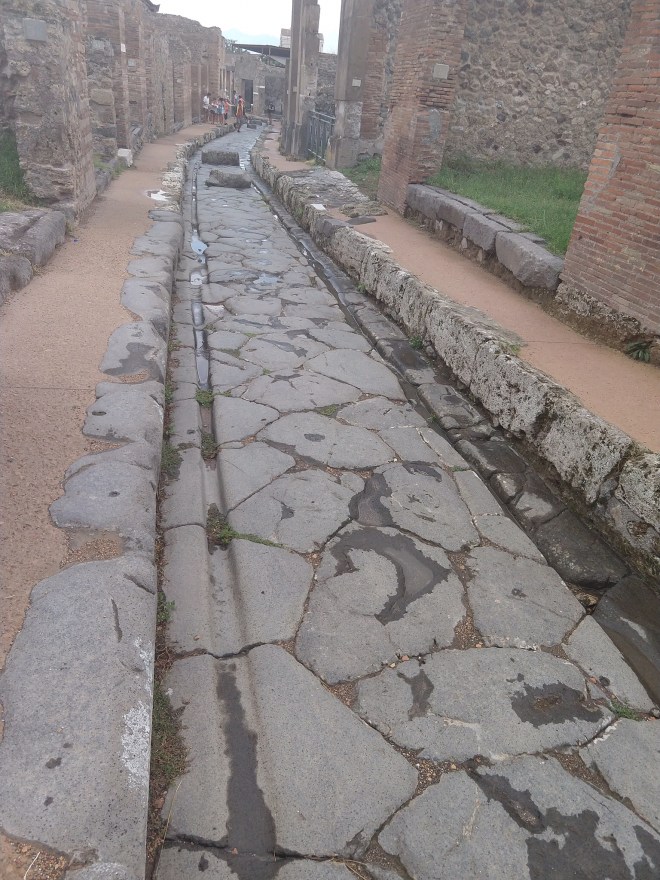
More chariot grooves – how many chariots had to drive here for these to be this distinct?!

Inside a home with mosaic floors, paintings on the back wall and a small bath in the middle. It’s crazy how well intact much of the city is!
Because Pompeii was a port city, it’s no surprise that many brothels have been uncovered there. Each house is the same, filled with several small rooms that hold a stone bed with paintings of different sexual positions above it from which the “buyer” could choose. Below is a photo of one of the beds as well as a photo of one of the less explicit pictures above it. It fascinating that even things like this are preserved in history and sad the way humans have treated one another for thousands of years. All the people working in these houses would have been slaves. 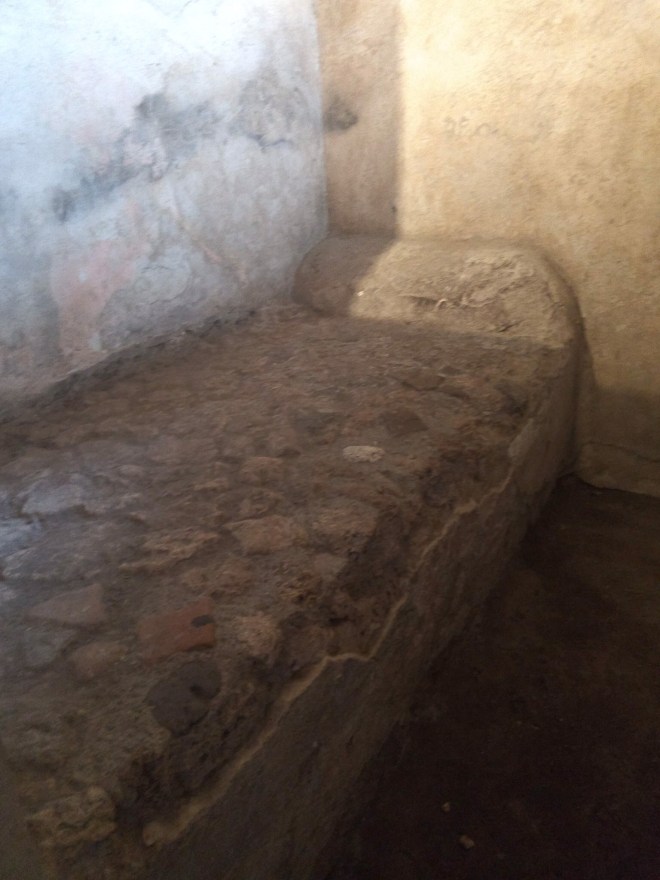
The stone brothel bed

One of the “position paintings” above the brothel bed.
One of the final areas Kirk visited in Pompeii was that of the colosseum and amphitheater. Both are still well in tact and have only been opened to the public recently.
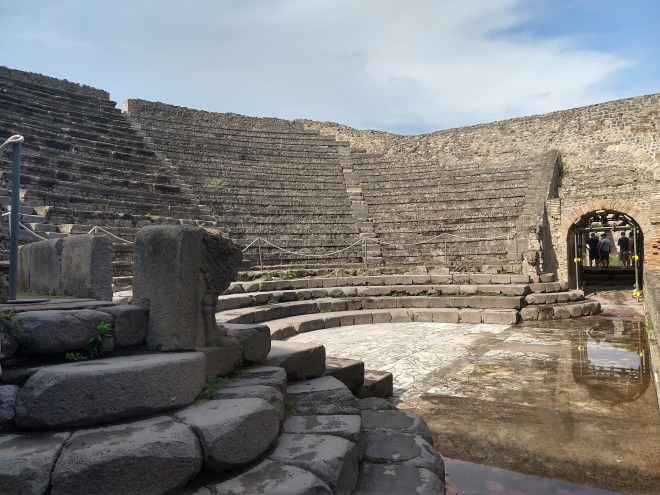
The amphitheater

Inside the amphitheater with the gymnasium behind it where athletes would have worked out.
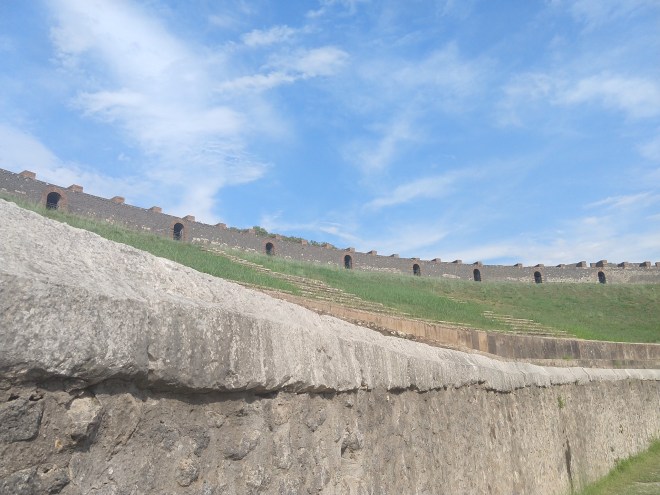
The colosseum
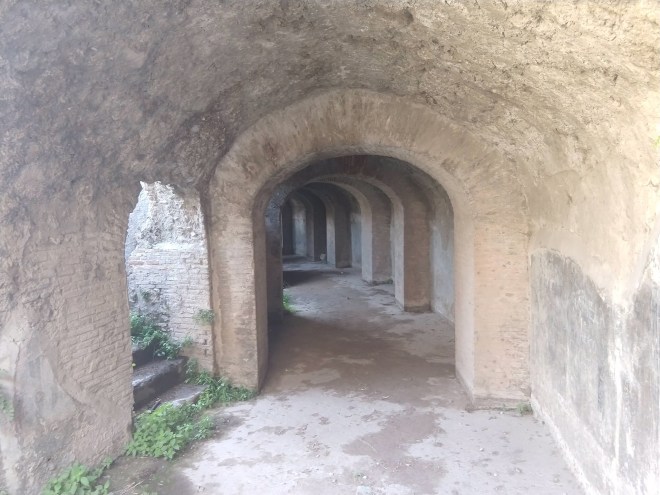
Walking underneath the stands of the colosseum. This colosseum was so well preserved!
The day after visiting Pompeii, we headed to the Naples Archeological Museum in hopes of seeing some of the many artifacts removed from Pompeii for preservation purposes. We were not disappointed. Alongside the Pompeii art and artifacts are also old statues from the Roman Empire and select pieces of modern art as well.
If less than fully clothed art makes you uncomfortable, much of this next section may not be for you. The Romans were big fans of putting the human body on display, and I’ve also included a few shots of some modern “body” art that we liked at the museum. You can either scroll quickly down to the paintings, or come back for the next blog. There isn’t much left to talk about after our visit to the museum.
Upon entering the museum, you are greeted by an enormous horse head, a work of art done by none other than Donatello.
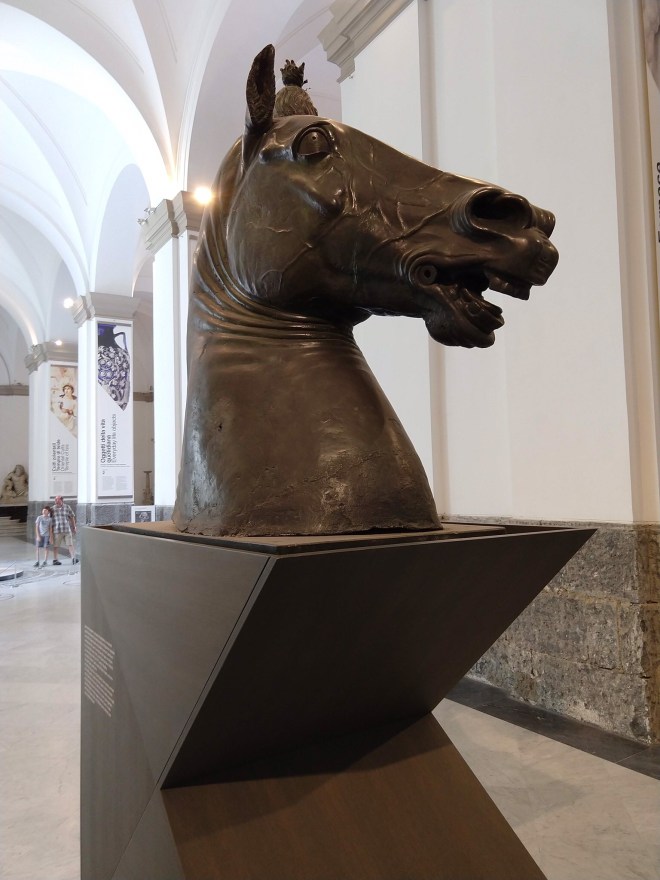
Horse head by Donatello, from the 1400’s
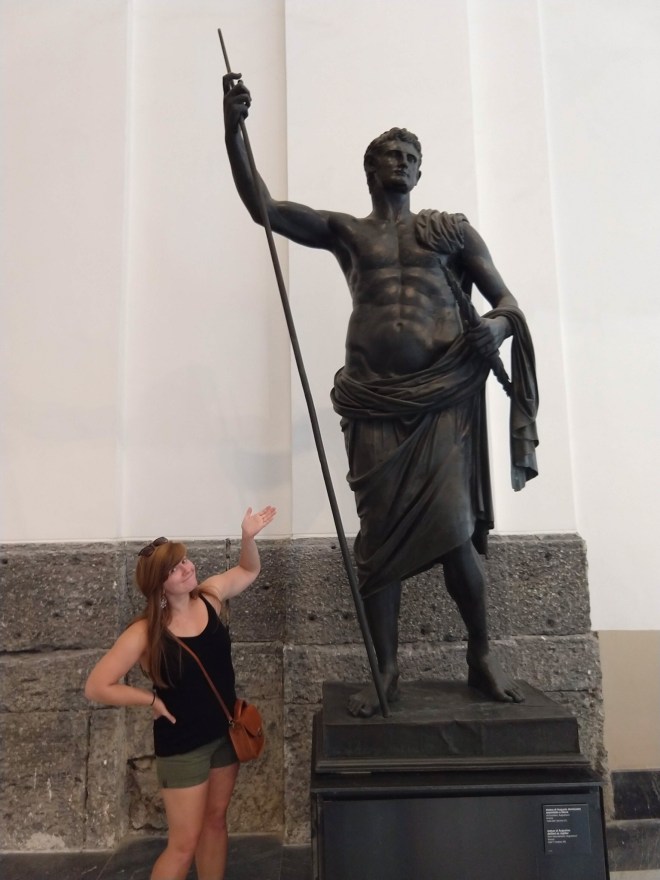
One of the preserved statues from Pompeii. As we did with many of the statues in this this museum, I’m next to him to show size 🙂
The next three pieces are modern art that were intermingled with the old statues. We thought were beautiful. The first two are carved from wood and the final is a bronze cast. The first of them looked strikingly similar to the “Golden Instrument” artist I posted about on the New Zealand blog who played classical piano while wearing gold paint and a bush over her head – symbolizing that her body was more than an object. Unfortunately, we didn’t get a picture of any of the plates on these statues and we can’t remember the name of the artist 😬 .
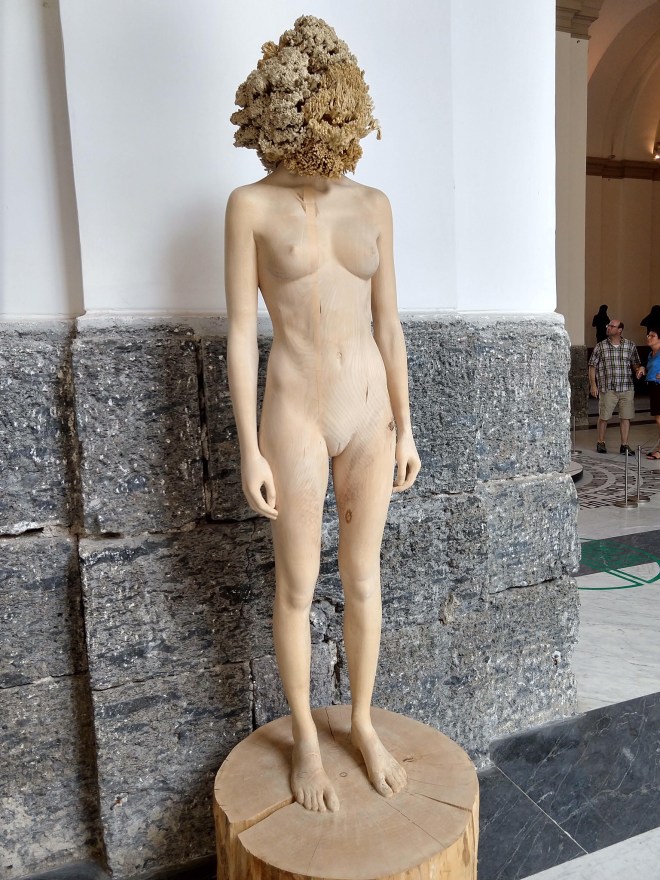
The statue that reminded us of the “Golden Instrument.”
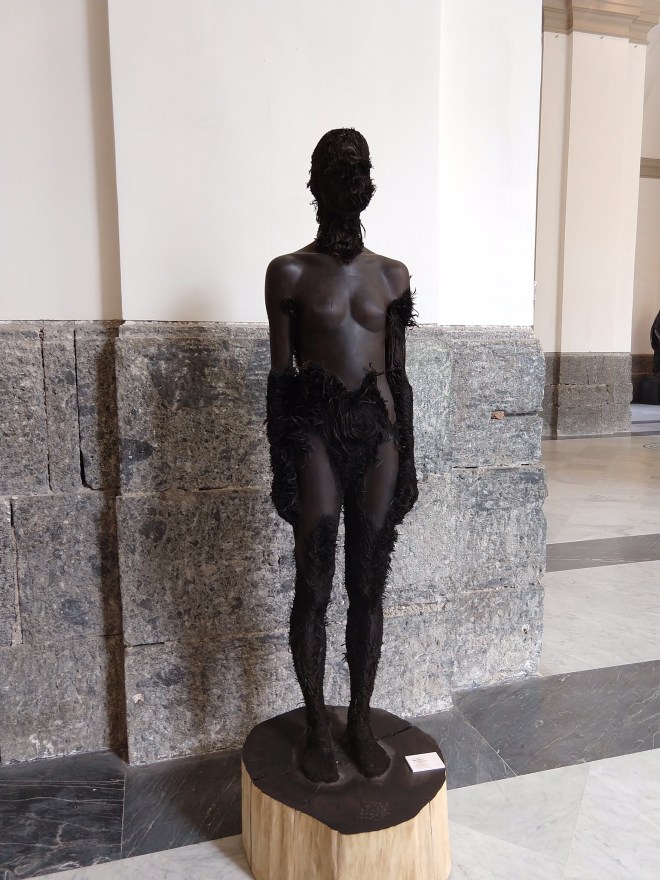
I loved the way the “shredded” parts of this one looked. It was my favorite of the modern art.
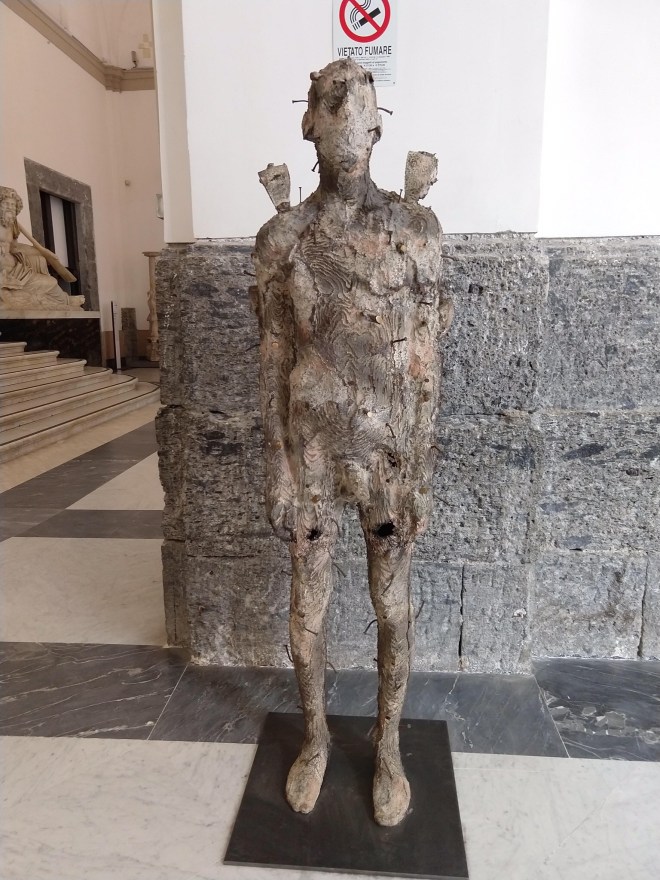
I’m unsure what is on the outside of the statue to make it look this way, but the statue itself is a bronze casting. The nails that look as if they are going into wood are an illusion. It is all a single metal casting.
As we turned into the room next door we soon encountered our first very large statue.

Look how tall this guy is!
We passed through many other smaller statues and busts before coming to another large piece of modern art from the same artist.
 It adds a different dimension to the art, not just having the statue carved smoothly out of the wood. I love it!
It adds a different dimension to the art, not just having the statue carved smoothly out of the wood. I love it!
As we rounded the corner we came across a small film crew. As we looked at the art nearby, we watched for a while as the director demonstrated what he wanted the girls in the video to do and did several retakes. I have no idea who this is or what it’s for, but our best guess is that it was some type of music video – possibly for a university course? Let us know if anyone sees it online 🤷♀️! Here’s a short clip the I took :).
Eventually we came to the Farnese collection. Over generations, the Farnese family (an influential family from the renaissance period) amassed a large collection of antiquities that they have now placed in the Naples museum. Among this collection are the enormous statues that once filled the Baths of Caracalla in Rome.
This Baths of Caracella were quite famous in their time. Built between 212-216AD, they covered over 62 acres and were the second largest bath complexes to come out of the Roman Empire. Enormous structures, enormous statues, and incredibly popular, the statues below are a few found there, including the original famous Hercules statue of which many replicas have been made.
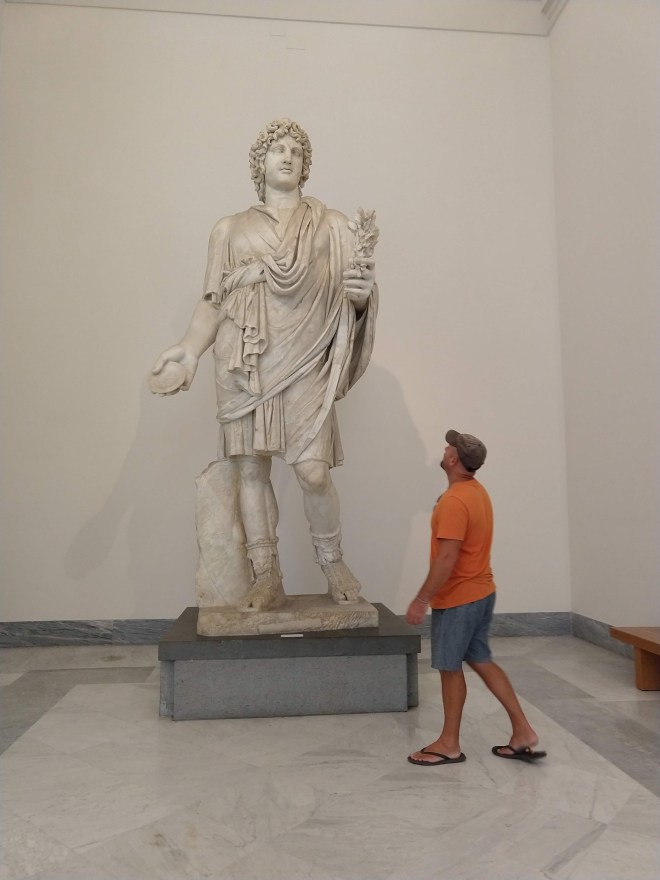
Kirk, next to one of those giants
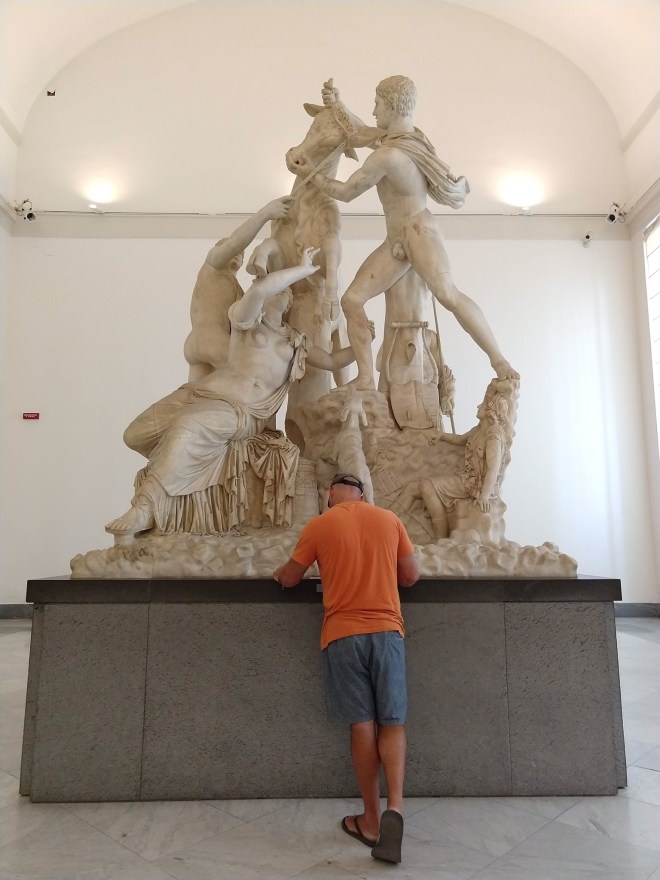
A very large statue that was likely part of a fountain in it’s time. The movement and struggle in this one was very realistic from all sides.

The famous Hercules statue

Hercules from the back with many of the other large statues in view
After the large statue display was a collection of pendants and gems from the Farnese family. Below is one of my favorites. It’s carved from a stone that was two toned. The white wasn’t glued on or added later, the artist simply (or not so simply…) used the color layers already available in the rock. There were many others like this as well. Amazing.
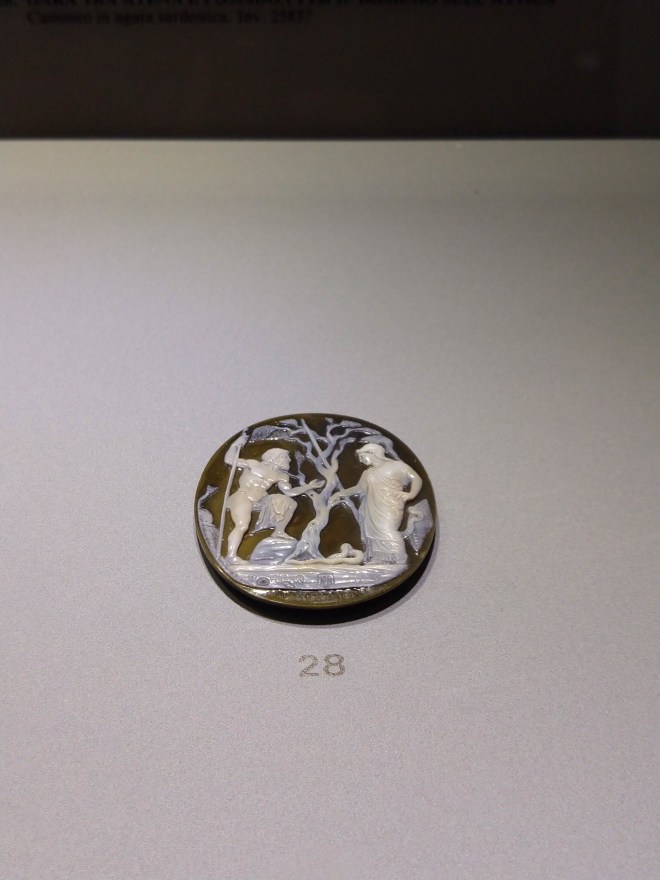
Look at the detail! This was about the size of a quarter!
After finishing the Farnese collection, we headed upstairs to view the many mosaics and paintings from Pompeii.

A small mosaic from a home in Pompeii

My favorite by far – the shading, the shadows, the movement, the faces, the colors. This mosaic was only around a foot and half long, so you can imagine how tiny the tiles were of which it was composed!
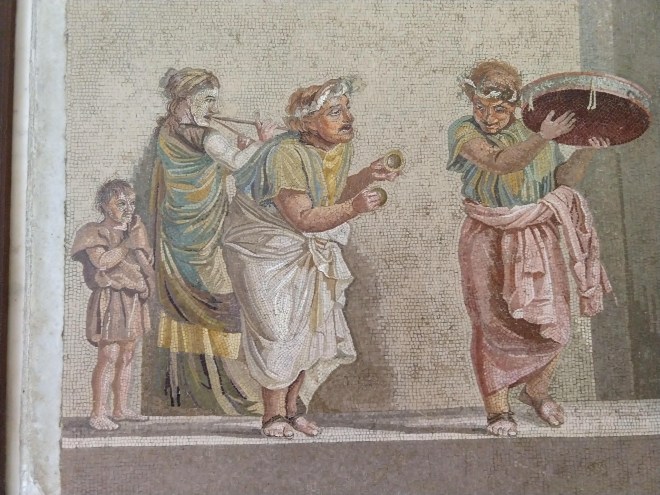
A closer view
In the middle of one mosaic room sat a small statue that should be familiar from the pictures above of Pompeii. Below is the original famous statue of the leaping nymph (he had a tail in the back…). My finger ended up in the picture because I was trying to quickly get out of the way, but the joy and movement in the statue is still in full view.
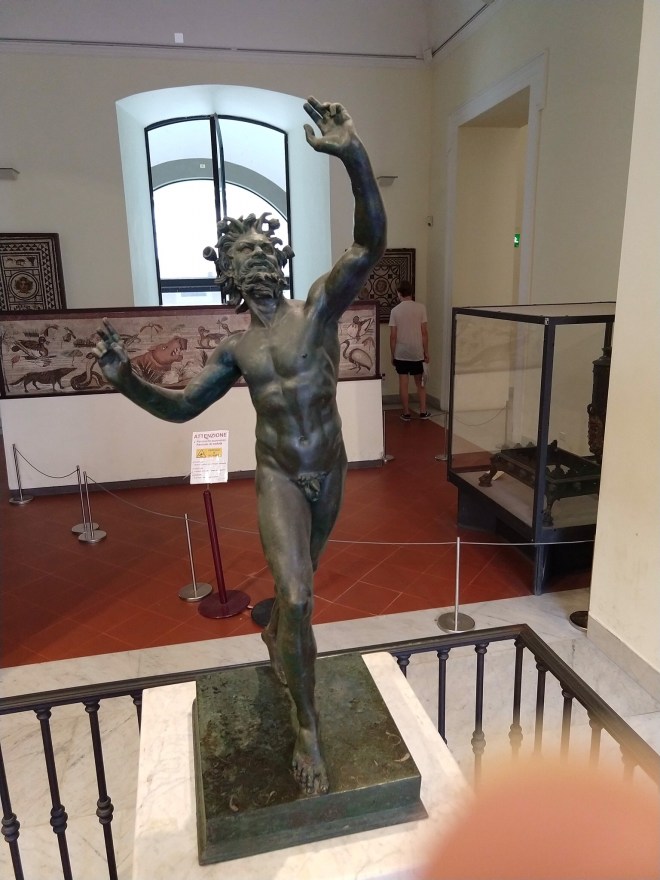
Joyous Nymph from Pompeii
There was one other section of the museum located next to the mosaics called the “secret room” from which I won’t post any pictures. The room wasn’t open to the public until 2000 because everything in the room is erotic art. Paintings taken from the brothels, sensual statues from people’s homes, and plenty of enormous phallic symbols, as this image in particular was a symbol of good luck in Pompeii in ancient times. Along the streets in Pompeii you can often find these same symbols carved next to the doors of people homes or on the roads. It’s amazing what history leaves behind.
The final section of the museum we visited was a section of paintings and walls that were taken from Pompeii as it was excavated. One of the things I remember being most surprised about in Pompeii when I visited a few years ago was the brightness and quality of the paint still on the walls nearly 2000 years later. It was common then to paint works of art directly on the wall, opposed to having something hanging in a frame. Keep that in mind while viewing the next several photos. Though these wall sections are now in frames, they were taken directly from the plaster on the walls of old Pompeii homes.
Below is one of the well known paintings of the collection. It’s a picture of a couple who likely died when the volcano erupted. Their faces have been preserved all these years later.

A couple from Pompeii

Kirk, checking out some of the art.
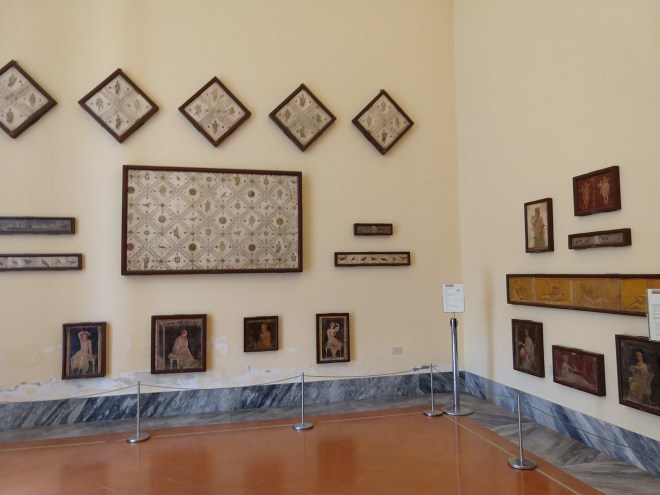
Paintings that looked like modern day wallpaper – I loved these :).

An entire wall painting that was preserved. Designs like this were common throughout Pompeii.

Impressive paintings of various foods and meals. Again. It’s amazing how well preserved these are!

A few final common wall paintings.
As Pompeii was initially uncovered, someone made a small replica of the entire city for reference. It’s a pretty amazing feat because they included many details that had to take some time to translate into a model – such as paintings on the walls in the homes and walls that are in disrepair. Below is that original model, but it isn’t comprehensive of all buildings in Pompeii, as more were found in later excavations. .

The original replica of Pompeii
As more of the city was uncovered, the map below was made to detail all that has been found up until this point. The statue next to the map is also out of Pompeii.
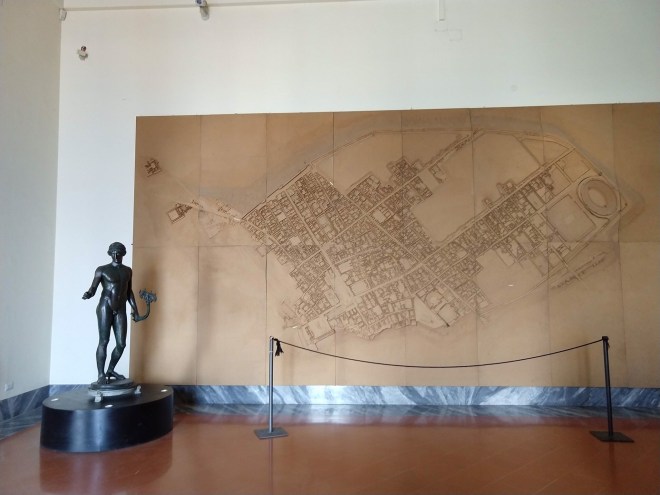
Modern day uncovered Pompeii.
The Naples Archeological Museum turned out to be one of my favorite archeological museums we’ve visited. It’s full of so many intact pieces of history – and from what we’ve seen – intact statues and arts are quite uncommon from the ancient world! It’s sad what happened to Pompeii, but it’s unbelievable what was preserved from that time!
Our final night in Naples we headed to a restaurant that was recommended by the Michelin Guide, Mimi Alla Ferrovia. It was affordable, and did not disappoint.

Our starter, Eggplant Parmesan. I don’t know what made this dish so special, but it was unlike any other eggplant Parmesan I’ve had. Fresh ingredients and perfectly seasoned, this was actually my favorite dish of the meal (and it was only around 4 euro!)
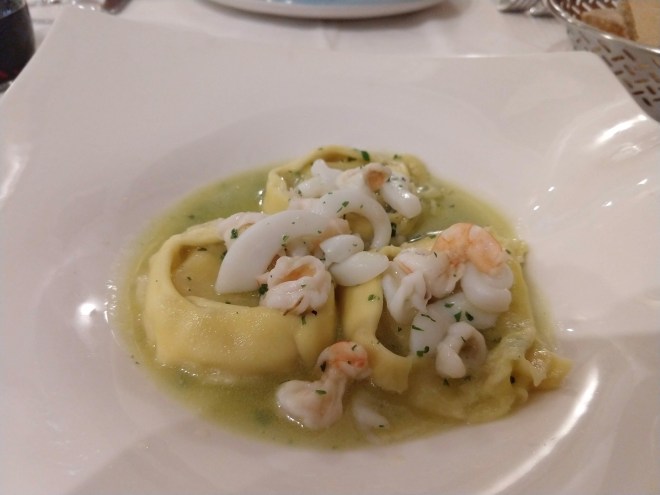
My dinner – their famous sea bass ravioli in a light lemon sauce. Yum!

Kirk’s dinner – the catch of the day. He raved and raved about this fish. It was basically just a plain grilled fish (no special sauce or marinade) cooked just right with light charring and and the perfect amount of sea salt on top. Simplified perfection with a mix of side toppings to go with it. Those pieces of zucchini and peppers were so delicious.
The next morning we hopped on a bus and headed to Rome, where there was tons of history waiting for us to explore. Next blog, Rome.